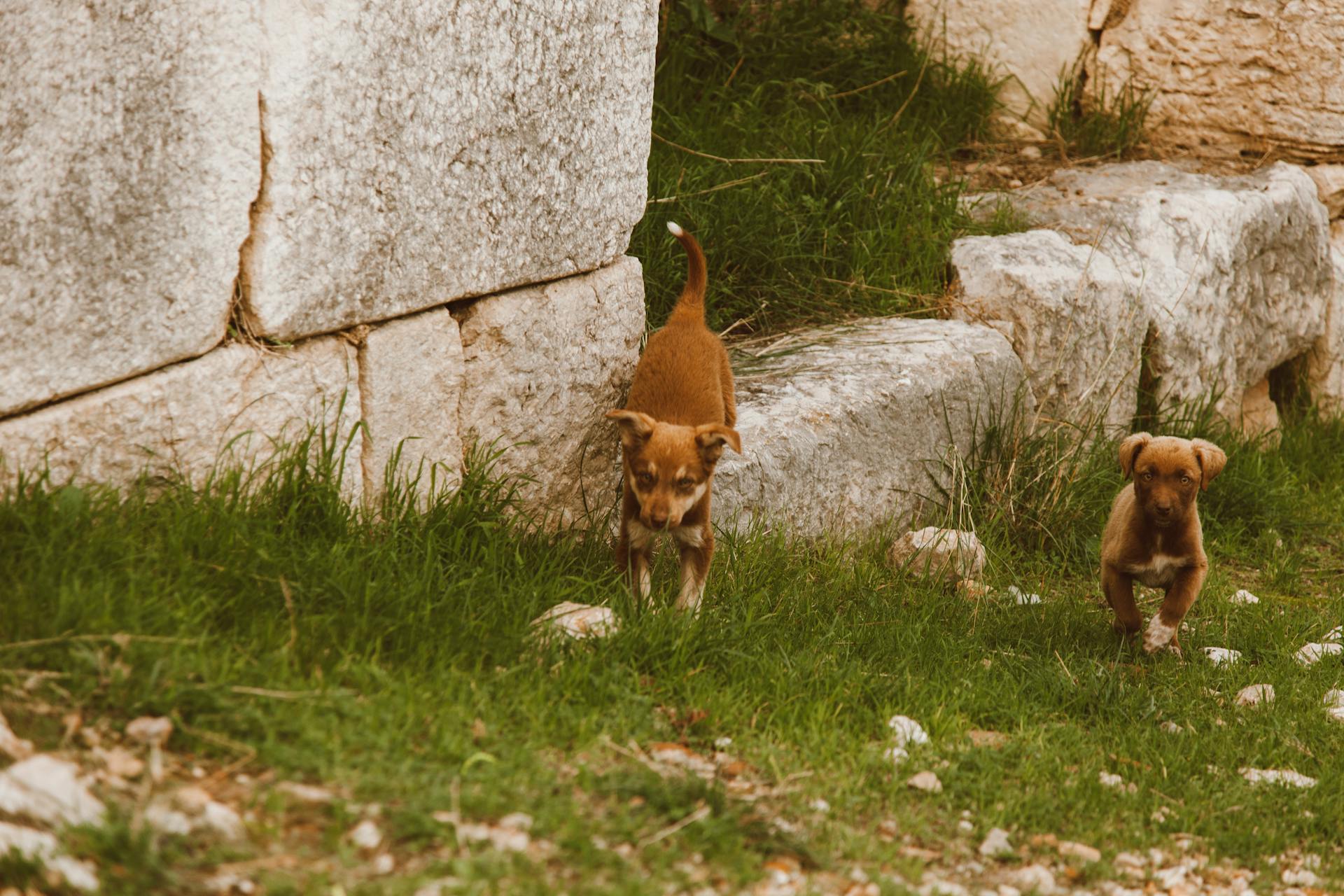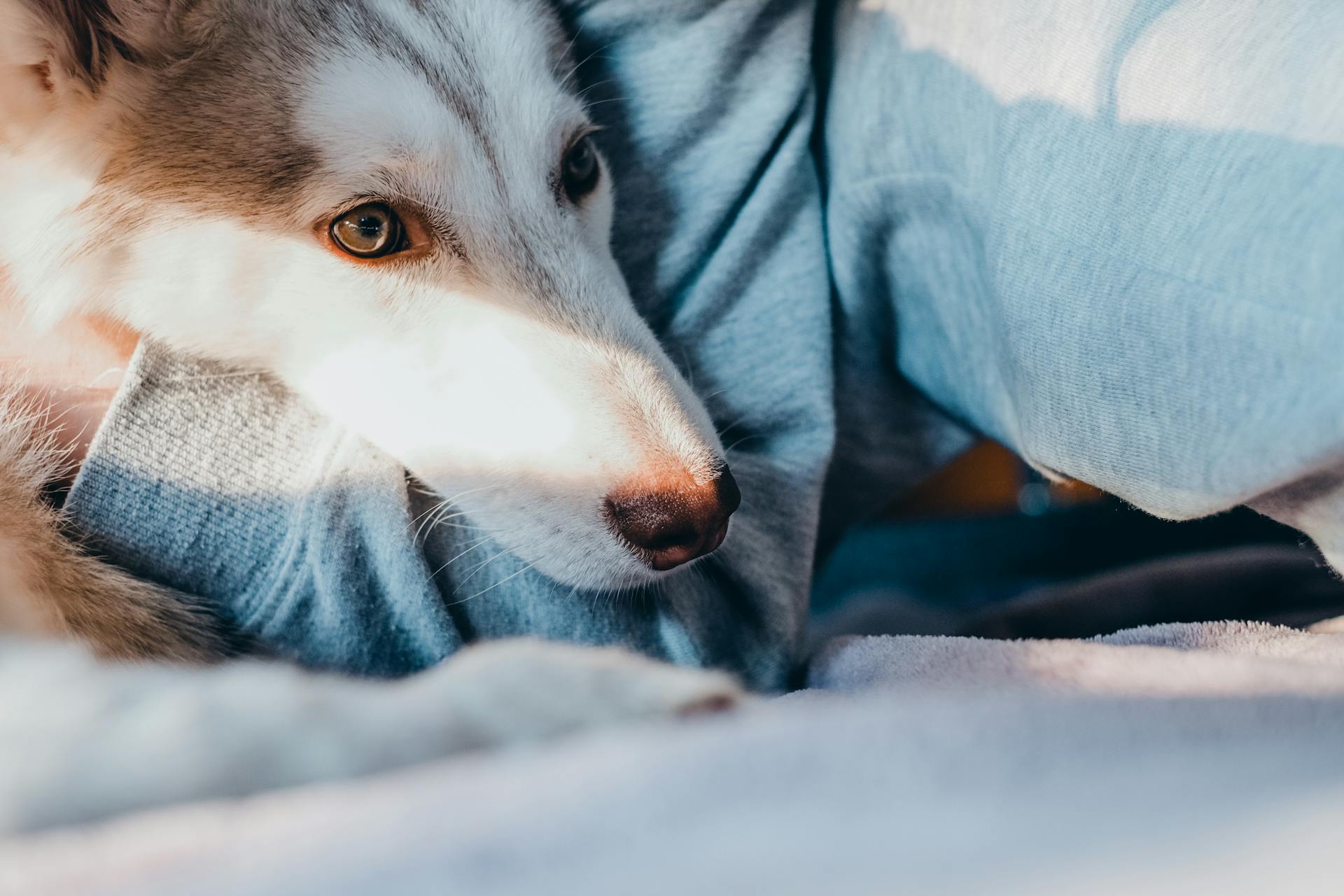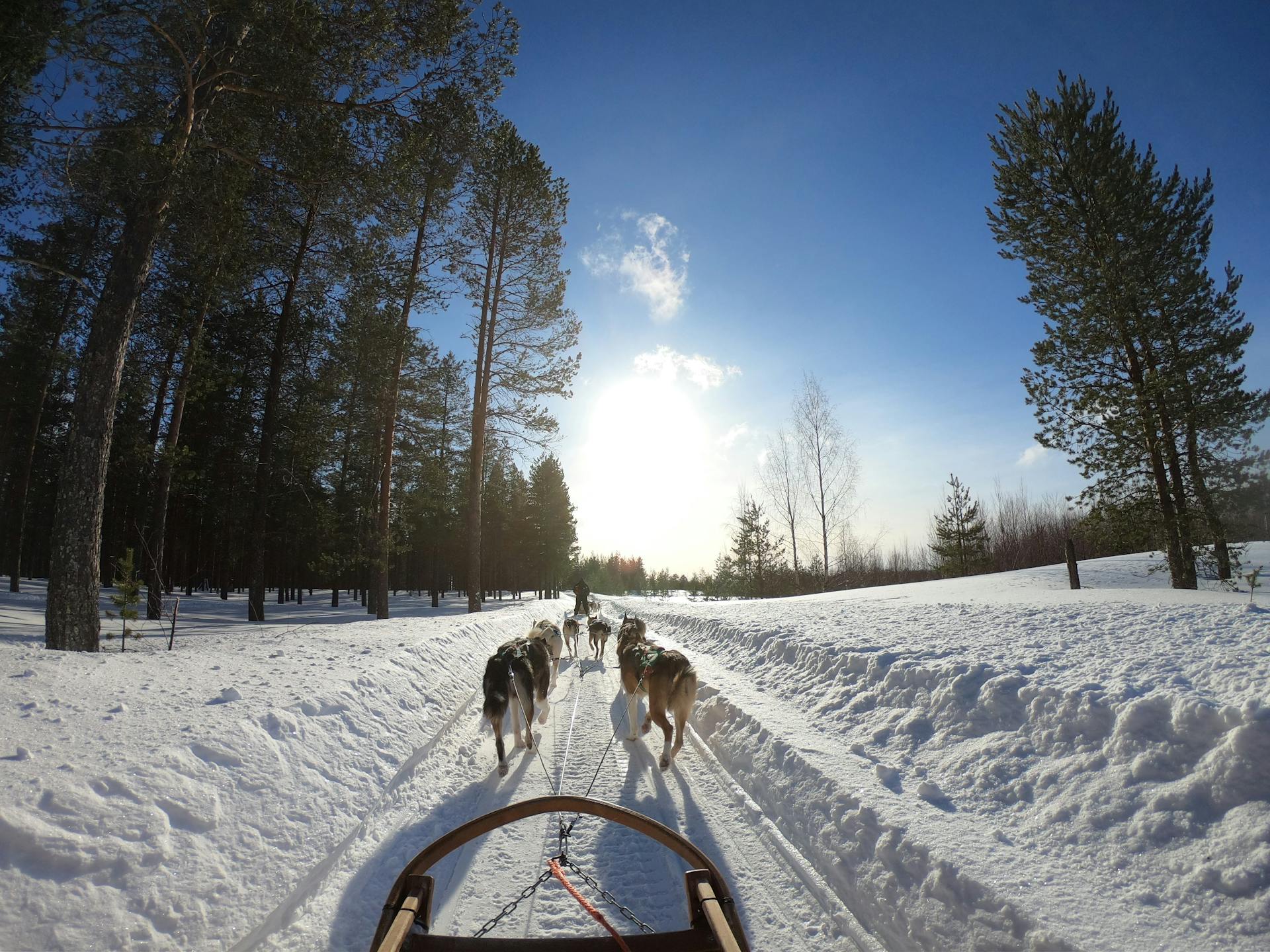
Meet Laika, the first dog in space, who paved the way for human space exploration. Laika was a stray dog from Moscow who was launched on November 3, 1957, aboard Sputnik 2.
Laika's mission was to test the safety of space travel for living organisms, and she played a crucial role in the Soviet space program. Laika was a small, 11-pound dog who was chosen for her calm temperament and small size.
Laika's journey lasted for only 5 hours, but her legacy lived on as a pioneer in space exploration. She was the first of many Soviet space dogs who would follow in her paw prints.
Recommended read: Merrick Dog Food for Small Dogs
Early Soviet Space Dogs
The first dogs to make a sub-orbital flight and successfully recover were Dezik and Tsygan on 22 July 1951.
They reached a maximum altitude of 110 km (68 mi) and were recovered unharmed.
Dezik made another sub-orbital flight in 1951 with Lisa, but unfortunately, the parachute failed to deploy.
Laika
Laika was a Soviet space dog who flew to space on Sputnik 2 on November 3, 1957, becoming the first Earth-born creature to orbit the planet.
She was also known as Zhuchka, Limonchik, and "Muttnik" by the American media. Laika was a canine, not a microbe.
Laika's true cause of death was not made public until October 2002, previously reported to be due to oxygen supply running out.
Chernushka
Chernushka was a pioneering space traveler.
Chernushka made one orbit on board Korabl-Sputnik-4 (Sputnik 9) on 9 March 1961.
The spacecraft carried a cosmonaut dummy nicknamed Ivan Ivanovich, mice, and a guinea pig.
Chernushka was recovered unharmed inside the capsule.
The dummy was ejected out of the capsule during re-entry and made a soft landing using a parachute.
Satellite Flights
Dezik and Tsygan were the first dogs to make a sub-orbital flight and successfully recovered on 22 July 1951.
Both dogs were recovered unharmed after traveling to a maximum altitude of 110 km (68 mi).
Dezik made another sub-orbital flight in 1951 with the first dog named Lisa, but unfortunately, neither survived because the parachute failed to deploy.
Tsygan was adopted as a pet by Soviet physicist Anatoli Blagonravov after the death of Dezik.
You might like: Laika First Dog
Pioneering Pairs
Pchyolka and Mushka were two dogs who spent a day in orbit on board Korabl-Sputnik-3 in 1960.
Mushka was one of the three dogs trained for Sputnik 2, but she didn't fly on the mission because she refused to eat properly.
Otvazhnaya made a flight on July 2, 1959, with a rabbit named Marfusha and another dog named Snezhinka. She went on to make 5 other flights between 1959 and 1960.
Damka and Krasavka were to make an orbital flight on December 22, 1960, but their mission was marked by a string of equipment failures.
A different take: A Dog Named Gucci
Belka and Strelka
Belka and Strelka were two brave space travelers who made history on August 19, 1960. They spent a day in space aboard Korabl-Sputnik 2, the first higher living organisms to survive orbit in outer space.
Belka, also known as "Whitey", was a squirrel, and Strelka, or "little arrow", was a dog. They were accompanied by a grey rabbit, 42 mice, two rats, flies, and several plants and fungi.
All of the passengers, including Belka and Strelka, survived the space journey and returned safely to Earth. They were the first Earth-born creatures to go into orbit and return alive.
Smelaya and Malyshka
Smelaya and Malyshka, a pioneering pair of space travelers, made history with their daring flight. Smelaya was a fearless female dog who was due to make a flight in September but ran away the day before the launch.
She was found the next day and went on to make a successful flight with a dog named Malyshka, who was affectionately known as "Baby". The two dogs were a perfect pair, working together to achieve their mission.
Unfortunately, their journey was cut short when the rocket failed to deploy a parachute, causing them to crash. Fortunately, they were found the next day by the recovery team, who were relieved to see that they were alive.
Smelaya and Malyshka's bravery and determination paved the way for future space travelers, and their story is an inspiring reminder of the power of teamwork and perseverance.
Albina and Tsyganka
Albina and Tsyganka made a notable flight on June 7, 1958, where they were both ejected from their capsule at an altitude of 85 km (53 mi) and landed safely.
Albina was initially shortlisted for Sputnik 2 but never flew in orbit.
Tsyganka, also known as "Gypsy girl", was part of this historic flight with Albina.
Bars and Lisichka
Bars and Lisichka were on a mission to orbit as part of the Vostok programme.
Bars, also known as Chayka, was named after a snow leopard. Lisichka, which means "little fox", tragically died after their rocket exploded 28.5 seconds into the launch on 28 July 1960.
Bars and Lisichka's rocket failure was not the only one, as Dymka, Modnitsa, and Kozyavka also experienced sub-orbital flights.
Bars and Lisichka's mission was part of a larger effort to push the boundaries of space exploration.
Veterok and Ugolyok
Veterok and Ugolyok were two dogs that made history in the Soviet space program. Launched on 22 February 1966, they spent 21 days in orbit before landing on 16 March.
This spaceflight of record-breaking duration was not surpassed by humans until Soyuz 11 in June 1971. The two dogs showed signs of "cardiovascular deconditioning" with dehydration, weight loss, loss of muscle and coordination.
Their recovery took several weeks, but they showed no long-term issues. This achievement marked a significant milestone in the Soviet space program, paving the way for future human spaceflight missions.
For your interest: Laika the Russian Space Dog
Notable Missions
The Soviet space dogs were truly pioneers in space exploration. They paved the way for human space travel.
Laika, a stray dog from Moscow, was the first animal to orbit the Earth in 1957. She was launched on Sputnik 2, a spacecraft designed to test the safety of space travel for living organisms.
Belka and Strelka, two dogs from Moscow, became the first dogs to survive a trip to space and return safely in 1960. They orbited the Earth on Sputnik 5, a spacecraft that also carried food, water, and medical supplies.
Curious to learn more? Check out: Moscow Water Dog
Circling the Earth 17 Times
Circling the Earth 17 times was a remarkable feat achieved by two brave dogs, Belka and Strelka, on their historic space mission.
The launch was the first to be televised, with the picture from the spaceship making its way to the Earth-based space center with only a short delay.
During takeoff, Belka and Strelka showed signs of agitation, with higher heart rates and breathing.
Consider reading: Strelka Space Dog

However, once the ship reached orbit, the indicators showed the pair was fine.
The dogs were fed a special space food, resembling the Russian dish kholodets, which provided them with the necessary fluids.
Their food was served in tubs attached underneath the seats, where they lay, and a signal opened the containers when it was time to eat.
The dogs wolfed down their food with delight, and once they were finished, the trays went back.
After completing 17 loops around the Earth, Belka and Strelka were successfully returned to Earth, having spent around 27 hours in orbit.
Their condition was good, even better than after some days in training, and they immediately recognized their rescuer, V.S. Georgiyevsky, and wanted cuddles.
Lisa-2 and Ryzhik
Lisa-2 and Ryzhik were two notable satellites that achieved a significant milestone in space exploration. They flew to an altitude of 100 km on June 2, 1954.
Lisa-2 and Ryzhik were given the names "Fox" and "Ginger" respectively, with "Fox" being the name for Lisa-2.
Check this out: Two Dog Names
What Happened Next

After the historic flight, scientists reassessed the risks of space travel and decided to limit the number of loops a human would have to perform to a minimum.
Belka and Strelka, the two dogs who accompanied Yury Gagarin on the mission, were honorably discharged and allowed to live out their days at the Institute.
Their popularity soared in the Soviet Union, with their likenesses appearing on banners, posters, and calendars.
Strelka gave birth to six healthy pups several months after the flight, which was a major milestone in the mission's success.
One of the pups, a white one named Pushok, caught the attention of Jacqueline Kennedy, the First Lady of the United States, who was so taken by him that a delegation was sent to retrieve him.
Training and Preparation
The Soviet space dogs underwent rigorous training to prepare them for the challenges of space travel. They were trained to stand still for long periods of time.
Their training also included wearing space suits, which would protect them from the harsh conditions of space. This was a crucial step in preparing them for the mission.
To simulate the intense acceleration of a rocket launch, the dogs were placed in centrifuges. This helped them get accustomed to the forces they would experience during liftoff.
In addition to these physical challenges, the dogs were also subjected to smaller and smaller cages to prepare them for the confines of the space module. This helped them adjust to the cramped quarters.
Feeding the dogs a nutritious jelly-like protein helped with digestion and prevented constipation, a common issue for space dogs. More than 60% of dogs to enter space were reportedly suffering from constipation and gallstones on arrival back to base.
Frequently Asked Questions
Did any Soviet space dogs survive?
Yes, most Soviet space dogs survived their missions, with only a few lost due to technical failures. The Soviet space program successfully launched missions with at least 57 dogs, many of whom flew multiple times.
Is Laika's body still in space?
Laika's remains were on Sputnik 2, which disintegrated during re-entry on 14 April 1958. Unfortunately, Laika's body did not survive re-entry and was destroyed.
How long did Laika survive in space?
Laika survived in space for approximately 5-7 hours before passing away due to overheating and panic. Her short but significant time in space sparked a mix of emotions worldwide.
Sources
- https://www.esdaw.eu/soviet-space-dogs.html
- https://en.wikipedia.org/wiki/Soviet_space_dogs
- https://www.rbth.com/history/335710-story-belka-strelka
- https://www.amusingplanet.com/2021/12/belka-and-strelka-soviet-space-dogs.html
- https://editions.covecollective.org/chronologies/soviet-space-dogs-laika-strelka-and-belka
Featured Images: pexels.com


